Report: Literacy Development Strategies for Young Children's Writing
VerifiedAdded on 2020/04/15
|10
|2407
|187
Report
AI Summary
This report focuses on developing literacy in young children's writing skills, specifically addressing the needs of two children, Harper and Madison. The report identifies their respective challenges: spelling for Harper and grammar for Madison. It proposes tailored teaching strategies, including guided writing activities and interactive games like 'Look and Write,' 'Spelling Fun,' and 'Synonym Scramble.' The report emphasizes the use of Information and Communication Technologies (ITC), particularly Interactive White Boards and Interactive Dictionaries, highlighting their features and benefits for enhancing learning. Assessment methods for evaluating progress are also detailed. The conclusion emphasizes the effectiveness of the proposed strategies and the importance of their proper implementation to foster academic skill development in young children.

Running head: DEVELOPING LITERACY IN YOUNG CHILDREN’S WRITING SKILLS
Developing Literacy in Young Children's Writing Skills
Name of the Student
Name of the University
Author note
Developing Literacy in Young Children's Writing Skills
Name of the Student
Name of the University
Author note
Paraphrase This Document
Need a fresh take? Get an instant paraphrase of this document with our AI Paraphraser

1DEVELOPING LITERACY IN YOUNG CHILDREN’S WRITING SKILLS
Executive Summary
The purpose of this report is to develop teaching strategies for fulfilling academic requirements
of two mentioned children. Apart from this, the report also consists of the expected learning
experiences of the students along with evaluating the importance and benefits of the ITC tools
used while developing the strategies.
Executive Summary
The purpose of this report is to develop teaching strategies for fulfilling academic requirements
of two mentioned children. Apart from this, the report also consists of the expected learning
experiences of the students along with evaluating the importance and benefits of the ITC tools
used while developing the strategies.
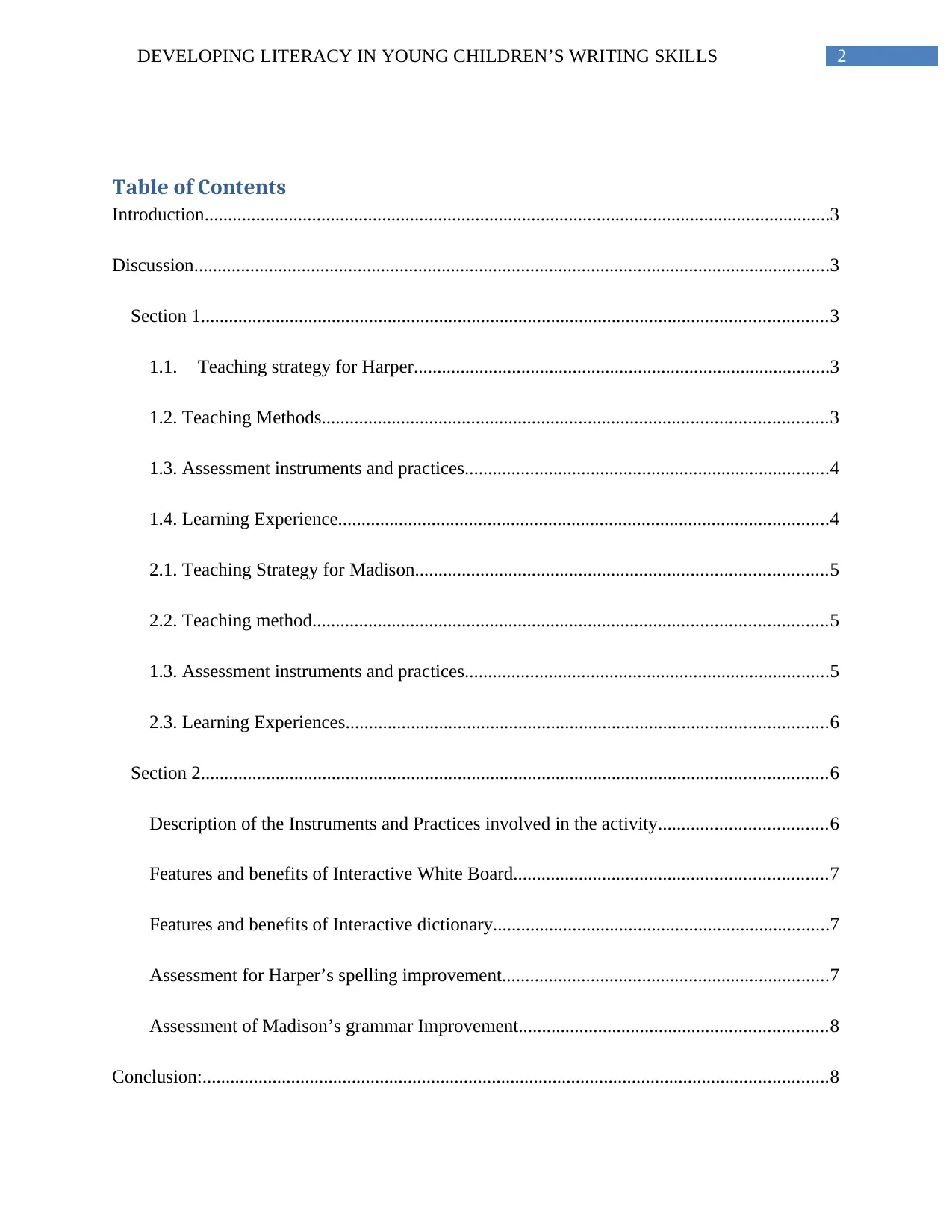
2DEVELOPING LITERACY IN YOUNG CHILDREN’S WRITING SKILLS
Table of Contents
Introduction......................................................................................................................................3
Discussion........................................................................................................................................3
Section 1......................................................................................................................................3
1.1. Teaching strategy for Harper.........................................................................................3
1.2. Teaching Methods............................................................................................................3
1.3. Assessment instruments and practices..............................................................................4
1.4. Learning Experience.........................................................................................................4
2.1. Teaching Strategy for Madison........................................................................................5
2.2. Teaching method..............................................................................................................5
1.3. Assessment instruments and practices..............................................................................5
2.3. Learning Experiences.......................................................................................................6
Section 2......................................................................................................................................6
Description of the Instruments and Practices involved in the activity....................................6
Features and benefits of Interactive White Board...................................................................7
Features and benefits of Interactive dictionary........................................................................7
Assessment for Harper’s spelling improvement......................................................................7
Assessment of Madison’s grammar Improvement..................................................................8
Conclusion:......................................................................................................................................8
Table of Contents
Introduction......................................................................................................................................3
Discussion........................................................................................................................................3
Section 1......................................................................................................................................3
1.1. Teaching strategy for Harper.........................................................................................3
1.2. Teaching Methods............................................................................................................3
1.3. Assessment instruments and practices..............................................................................4
1.4. Learning Experience.........................................................................................................4
2.1. Teaching Strategy for Madison........................................................................................5
2.2. Teaching method..............................................................................................................5
1.3. Assessment instruments and practices..............................................................................5
2.3. Learning Experiences.......................................................................................................6
Section 2......................................................................................................................................6
Description of the Instruments and Practices involved in the activity....................................6
Features and benefits of Interactive White Board...................................................................7
Features and benefits of Interactive dictionary........................................................................7
Assessment for Harper’s spelling improvement......................................................................7
Assessment of Madison’s grammar Improvement..................................................................8
Conclusion:......................................................................................................................................8
⊘ This is a preview!⊘
Do you want full access?
Subscribe today to unlock all pages.

Trusted by 1+ million students worldwide
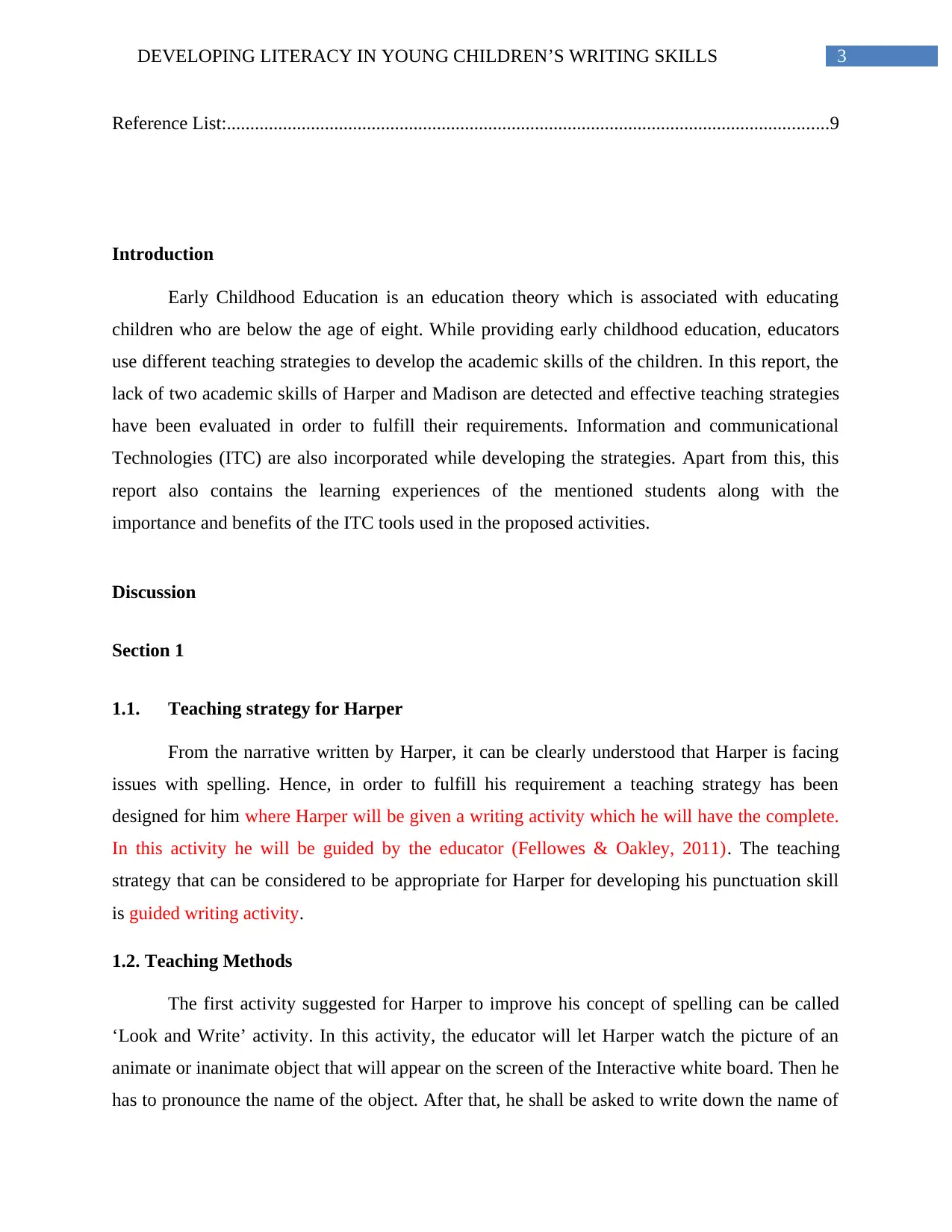
3DEVELOPING LITERACY IN YOUNG CHILDREN’S WRITING SKILLS
Reference List:.................................................................................................................................9
Introduction
Early Childhood Education is an education theory which is associated with educating
children who are below the age of eight. While providing early childhood education, educators
use different teaching strategies to develop the academic skills of the children. In this report, the
lack of two academic skills of Harper and Madison are detected and effective teaching strategies
have been evaluated in order to fulfill their requirements. Information and communicational
Technologies (ITC) are also incorporated while developing the strategies. Apart from this, this
report also contains the learning experiences of the mentioned students along with the
importance and benefits of the ITC tools used in the proposed activities.
Discussion
Section 1
1.1. Teaching strategy for Harper
From the narrative written by Harper, it can be clearly understood that Harper is facing
issues with spelling. Hence, in order to fulfill his requirement a teaching strategy has been
designed for him where Harper will be given a writing activity which he will have the complete.
In this activity he will be guided by the educator (Fellowes & Oakley, 2011). The teaching
strategy that can be considered to be appropriate for Harper for developing his punctuation skill
is guided writing activity.
1.2. Teaching Methods
The first activity suggested for Harper to improve his concept of spelling can be called
‘Look and Write’ activity. In this activity, the educator will let Harper watch the picture of an
animate or inanimate object that will appear on the screen of the Interactive white board. Then he
has to pronounce the name of the object. After that, he shall be asked to write down the name of
Reference List:.................................................................................................................................9
Introduction
Early Childhood Education is an education theory which is associated with educating
children who are below the age of eight. While providing early childhood education, educators
use different teaching strategies to develop the academic skills of the children. In this report, the
lack of two academic skills of Harper and Madison are detected and effective teaching strategies
have been evaluated in order to fulfill their requirements. Information and communicational
Technologies (ITC) are also incorporated while developing the strategies. Apart from this, this
report also contains the learning experiences of the mentioned students along with the
importance and benefits of the ITC tools used in the proposed activities.
Discussion
Section 1
1.1. Teaching strategy for Harper
From the narrative written by Harper, it can be clearly understood that Harper is facing
issues with spelling. Hence, in order to fulfill his requirement a teaching strategy has been
designed for him where Harper will be given a writing activity which he will have the complete.
In this activity he will be guided by the educator (Fellowes & Oakley, 2011). The teaching
strategy that can be considered to be appropriate for Harper for developing his punctuation skill
is guided writing activity.
1.2. Teaching Methods
The first activity suggested for Harper to improve his concept of spelling can be called
‘Look and Write’ activity. In this activity, the educator will let Harper watch the picture of an
animate or inanimate object that will appear on the screen of the Interactive white board. Then he
has to pronounce the name of the object. After that, he shall be asked to write down the name of
Paraphrase This Document
Need a fresh take? Get an instant paraphrase of this document with our AI Paraphraser
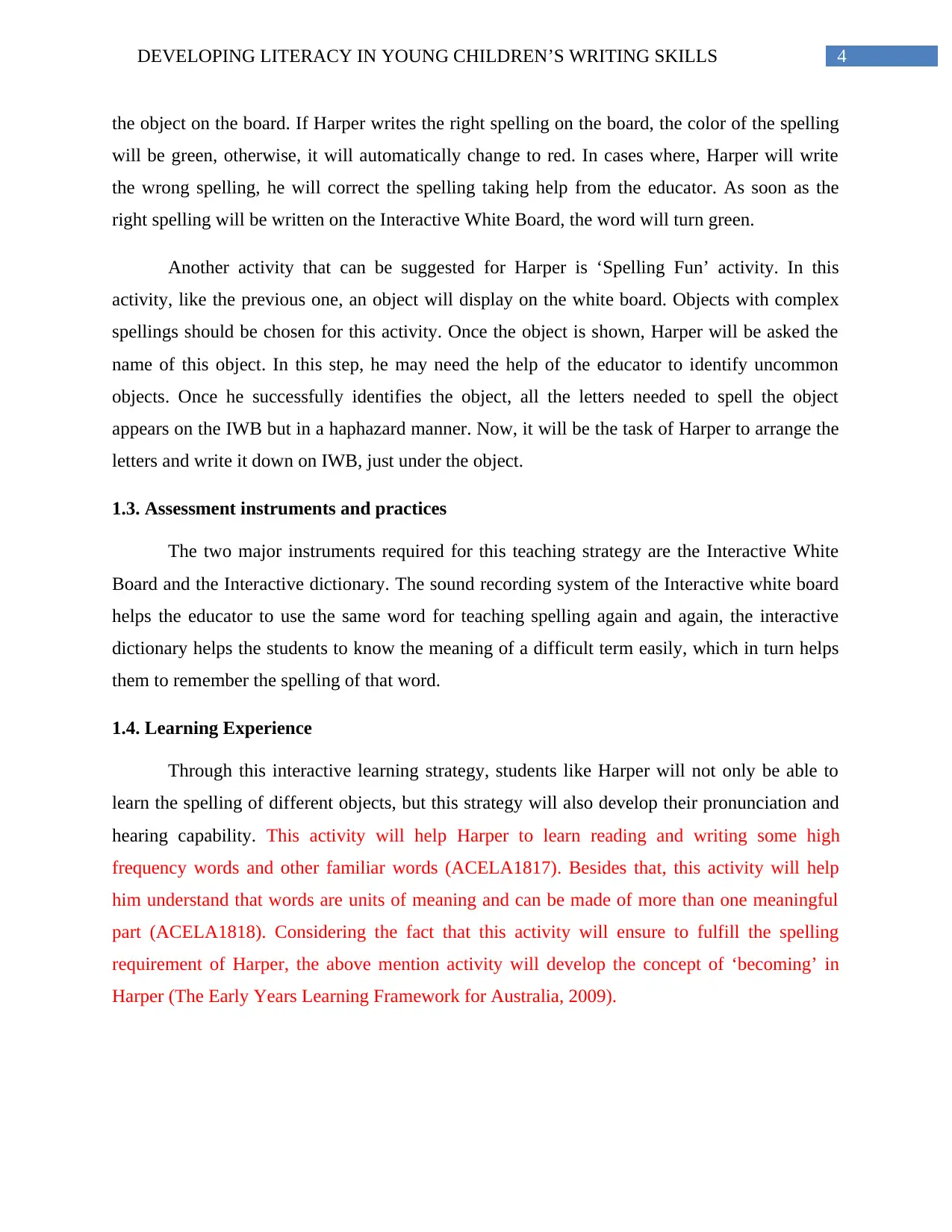
4DEVELOPING LITERACY IN YOUNG CHILDREN’S WRITING SKILLS
the object on the board. If Harper writes the right spelling on the board, the color of the spelling
will be green, otherwise, it will automatically change to red. In cases where, Harper will write
the wrong spelling, he will correct the spelling taking help from the educator. As soon as the
right spelling will be written on the Interactive White Board, the word will turn green.
Another activity that can be suggested for Harper is ‘Spelling Fun’ activity. In this
activity, like the previous one, an object will display on the white board. Objects with complex
spellings should be chosen for this activity. Once the object is shown, Harper will be asked the
name of this object. In this step, he may need the help of the educator to identify uncommon
objects. Once he successfully identifies the object, all the letters needed to spell the object
appears on the IWB but in a haphazard manner. Now, it will be the task of Harper to arrange the
letters and write it down on IWB, just under the object.
1.3. Assessment instruments and practices
The two major instruments required for this teaching strategy are the Interactive White
Board and the Interactive dictionary. The sound recording system of the Interactive white board
helps the educator to use the same word for teaching spelling again and again, the interactive
dictionary helps the students to know the meaning of a difficult term easily, which in turn helps
them to remember the spelling of that word.
1.4. Learning Experience
Through this interactive learning strategy, students like Harper will not only be able to
learn the spelling of different objects, but this strategy will also develop their pronunciation and
hearing capability. This activity will help Harper to learn reading and writing some high
frequency words and other familiar words (ACELA1817). Besides that, this activity will help
him understand that words are units of meaning and can be made of more than one meaningful
part (ACELA1818). Considering the fact that this activity will ensure to fulfill the spelling
requirement of Harper, the above mention activity will develop the concept of ‘becoming’ in
Harper (The Early Years Learning Framework for Australia, 2009).
the object on the board. If Harper writes the right spelling on the board, the color of the spelling
will be green, otherwise, it will automatically change to red. In cases where, Harper will write
the wrong spelling, he will correct the spelling taking help from the educator. As soon as the
right spelling will be written on the Interactive White Board, the word will turn green.
Another activity that can be suggested for Harper is ‘Spelling Fun’ activity. In this
activity, like the previous one, an object will display on the white board. Objects with complex
spellings should be chosen for this activity. Once the object is shown, Harper will be asked the
name of this object. In this step, he may need the help of the educator to identify uncommon
objects. Once he successfully identifies the object, all the letters needed to spell the object
appears on the IWB but in a haphazard manner. Now, it will be the task of Harper to arrange the
letters and write it down on IWB, just under the object.
1.3. Assessment instruments and practices
The two major instruments required for this teaching strategy are the Interactive White
Board and the Interactive dictionary. The sound recording system of the Interactive white board
helps the educator to use the same word for teaching spelling again and again, the interactive
dictionary helps the students to know the meaning of a difficult term easily, which in turn helps
them to remember the spelling of that word.
1.4. Learning Experience
Through this interactive learning strategy, students like Harper will not only be able to
learn the spelling of different objects, but this strategy will also develop their pronunciation and
hearing capability. This activity will help Harper to learn reading and writing some high
frequency words and other familiar words (ACELA1817). Besides that, this activity will help
him understand that words are units of meaning and can be made of more than one meaningful
part (ACELA1818). Considering the fact that this activity will ensure to fulfill the spelling
requirement of Harper, the above mention activity will develop the concept of ‘becoming’ in
Harper (The Early Years Learning Framework for Australia, 2009).
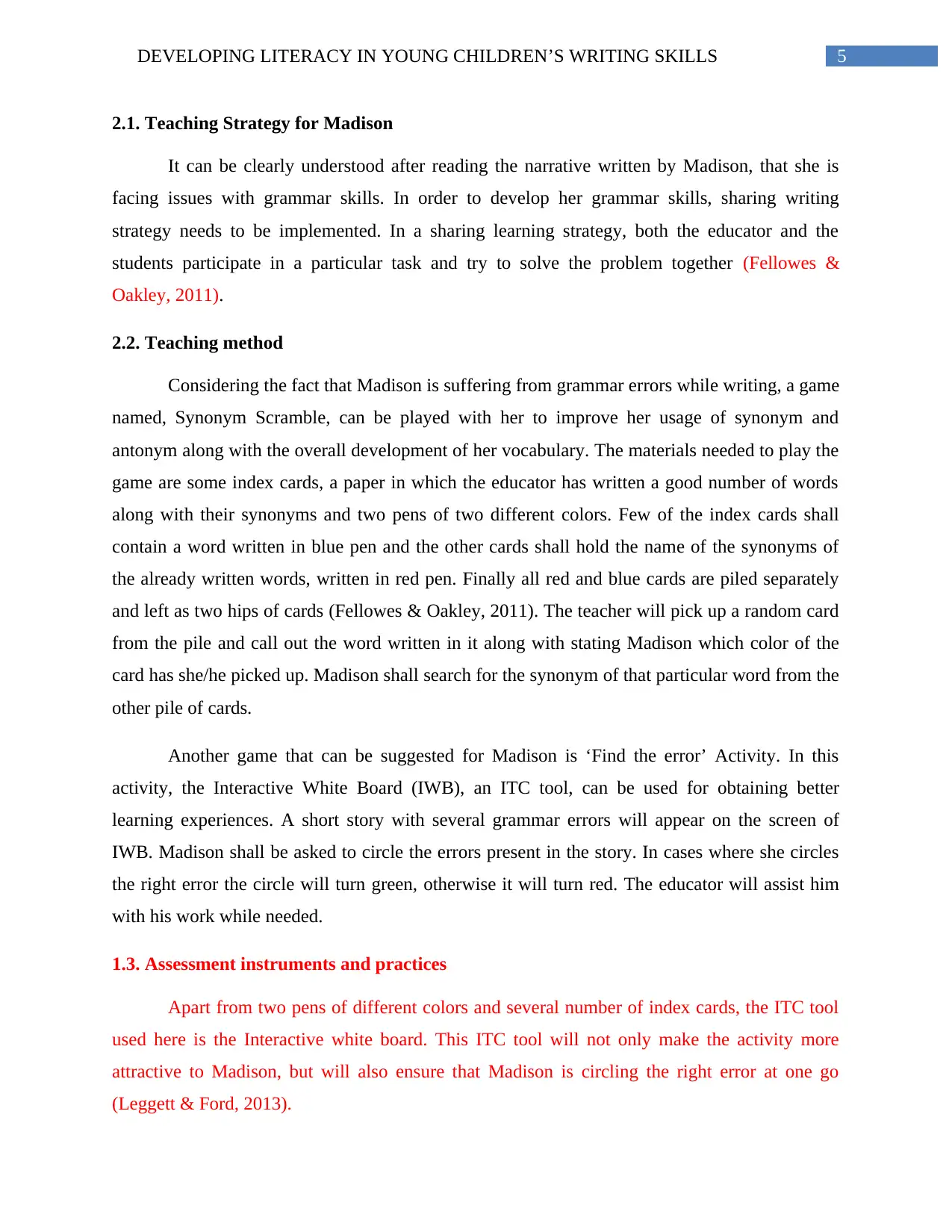
5DEVELOPING LITERACY IN YOUNG CHILDREN’S WRITING SKILLS
2.1. Teaching Strategy for Madison
It can be clearly understood after reading the narrative written by Madison, that she is
facing issues with grammar skills. In order to develop her grammar skills, sharing writing
strategy needs to be implemented. In a sharing learning strategy, both the educator and the
students participate in a particular task and try to solve the problem together (Fellowes &
Oakley, 2011).
2.2. Teaching method
Considering the fact that Madison is suffering from grammar errors while writing, a game
named, Synonym Scramble, can be played with her to improve her usage of synonym and
antonym along with the overall development of her vocabulary. The materials needed to play the
game are some index cards, a paper in which the educator has written a good number of words
along with their synonyms and two pens of two different colors. Few of the index cards shall
contain a word written in blue pen and the other cards shall hold the name of the synonyms of
the already written words, written in red pen. Finally all red and blue cards are piled separately
and left as two hips of cards (Fellowes & Oakley, 2011). The teacher will pick up a random card
from the pile and call out the word written in it along with stating Madison which color of the
card has she/he picked up. Madison shall search for the synonym of that particular word from the
other pile of cards.
Another game that can be suggested for Madison is ‘Find the error’ Activity. In this
activity, the Interactive White Board (IWB), an ITC tool, can be used for obtaining better
learning experiences. A short story with several grammar errors will appear on the screen of
IWB. Madison shall be asked to circle the errors present in the story. In cases where she circles
the right error the circle will turn green, otherwise it will turn red. The educator will assist him
with his work while needed.
1.3. Assessment instruments and practices
Apart from two pens of different colors and several number of index cards, the ITC tool
used here is the Interactive white board. This ITC tool will not only make the activity more
attractive to Madison, but will also ensure that Madison is circling the right error at one go
(Leggett & Ford, 2013).
2.1. Teaching Strategy for Madison
It can be clearly understood after reading the narrative written by Madison, that she is
facing issues with grammar skills. In order to develop her grammar skills, sharing writing
strategy needs to be implemented. In a sharing learning strategy, both the educator and the
students participate in a particular task and try to solve the problem together (Fellowes &
Oakley, 2011).
2.2. Teaching method
Considering the fact that Madison is suffering from grammar errors while writing, a game
named, Synonym Scramble, can be played with her to improve her usage of synonym and
antonym along with the overall development of her vocabulary. The materials needed to play the
game are some index cards, a paper in which the educator has written a good number of words
along with their synonyms and two pens of two different colors. Few of the index cards shall
contain a word written in blue pen and the other cards shall hold the name of the synonyms of
the already written words, written in red pen. Finally all red and blue cards are piled separately
and left as two hips of cards (Fellowes & Oakley, 2011). The teacher will pick up a random card
from the pile and call out the word written in it along with stating Madison which color of the
card has she/he picked up. Madison shall search for the synonym of that particular word from the
other pile of cards.
Another game that can be suggested for Madison is ‘Find the error’ Activity. In this
activity, the Interactive White Board (IWB), an ITC tool, can be used for obtaining better
learning experiences. A short story with several grammar errors will appear on the screen of
IWB. Madison shall be asked to circle the errors present in the story. In cases where she circles
the right error the circle will turn green, otherwise it will turn red. The educator will assist him
with his work while needed.
1.3. Assessment instruments and practices
Apart from two pens of different colors and several number of index cards, the ITC tool
used here is the Interactive white board. This ITC tool will not only make the activity more
attractive to Madison, but will also ensure that Madison is circling the right error at one go
(Leggett & Ford, 2013).
⊘ This is a preview!⊘
Do you want full access?
Subscribe today to unlock all pages.

Trusted by 1+ million students worldwide
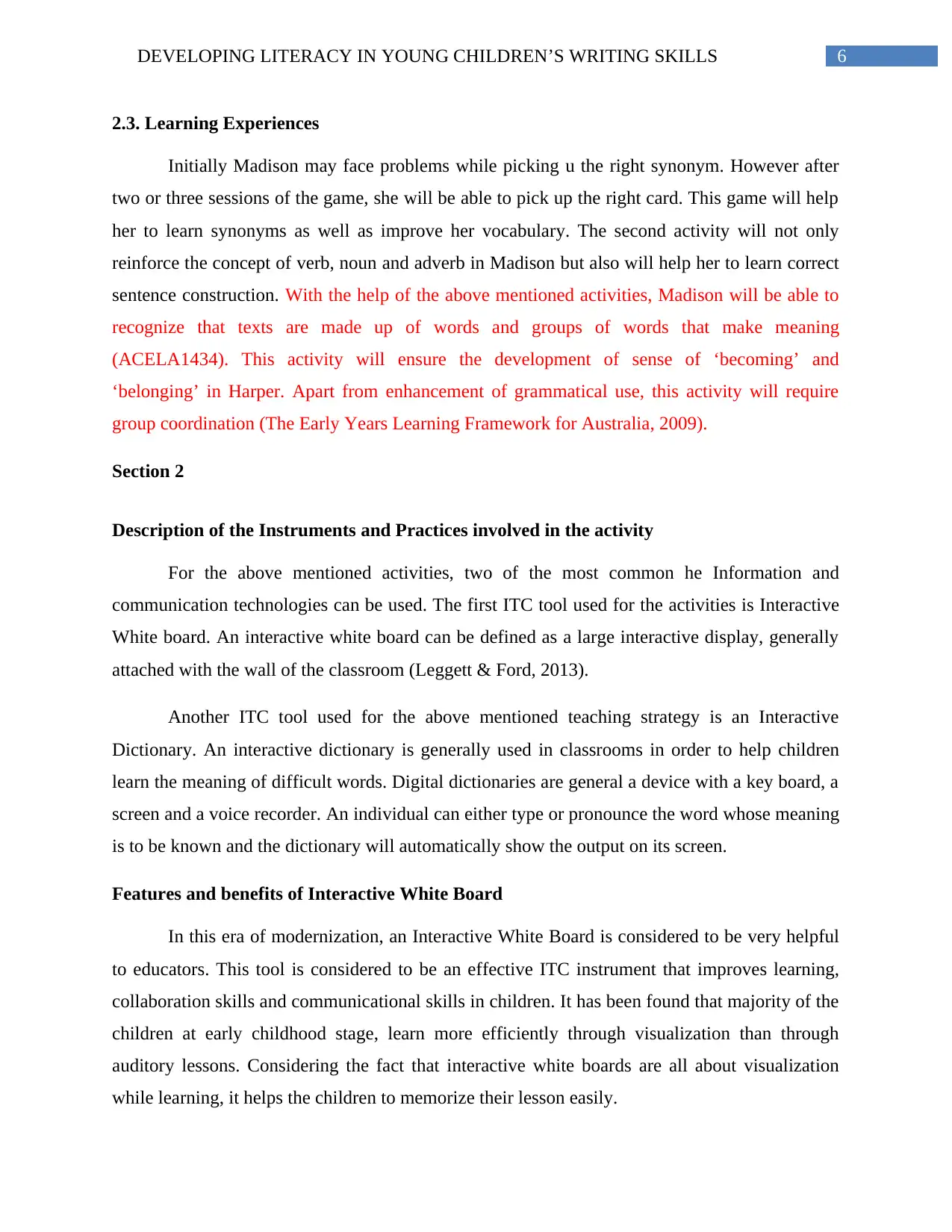
6DEVELOPING LITERACY IN YOUNG CHILDREN’S WRITING SKILLS
2.3. Learning Experiences
Initially Madison may face problems while picking u the right synonym. However after
two or three sessions of the game, she will be able to pick up the right card. This game will help
her to learn synonyms as well as improve her vocabulary. The second activity will not only
reinforce the concept of verb, noun and adverb in Madison but also will help her to learn correct
sentence construction. With the help of the above mentioned activities, Madison will be able to
recognize that texts are made up of words and groups of words that make meaning
(ACELA1434). This activity will ensure the development of sense of ‘becoming’ and
‘belonging’ in Harper. Apart from enhancement of grammatical use, this activity will require
group coordination (The Early Years Learning Framework for Australia, 2009).
Section 2
Description of the Instruments and Practices involved in the activity
For the above mentioned activities, two of the most common he Information and
communication technologies can be used. The first ITC tool used for the activities is Interactive
White board. An interactive white board can be defined as a large interactive display, generally
attached with the wall of the classroom (Leggett & Ford, 2013).
Another ITC tool used for the above mentioned teaching strategy is an Interactive
Dictionary. An interactive dictionary is generally used in classrooms in order to help children
learn the meaning of difficult words. Digital dictionaries are general a device with a key board, a
screen and a voice recorder. An individual can either type or pronounce the word whose meaning
is to be known and the dictionary will automatically show the output on its screen.
Features and benefits of Interactive White Board
In this era of modernization, an Interactive White Board is considered to be very helpful
to educators. This tool is considered to be an effective ITC instrument that improves learning,
collaboration skills and communicational skills in children. It has been found that majority of the
children at early childhood stage, learn more efficiently through visualization than through
auditory lessons. Considering the fact that interactive white boards are all about visualization
while learning, it helps the children to memorize their lesson easily.
2.3. Learning Experiences
Initially Madison may face problems while picking u the right synonym. However after
two or three sessions of the game, she will be able to pick up the right card. This game will help
her to learn synonyms as well as improve her vocabulary. The second activity will not only
reinforce the concept of verb, noun and adverb in Madison but also will help her to learn correct
sentence construction. With the help of the above mentioned activities, Madison will be able to
recognize that texts are made up of words and groups of words that make meaning
(ACELA1434). This activity will ensure the development of sense of ‘becoming’ and
‘belonging’ in Harper. Apart from enhancement of grammatical use, this activity will require
group coordination (The Early Years Learning Framework for Australia, 2009).
Section 2
Description of the Instruments and Practices involved in the activity
For the above mentioned activities, two of the most common he Information and
communication technologies can be used. The first ITC tool used for the activities is Interactive
White board. An interactive white board can be defined as a large interactive display, generally
attached with the wall of the classroom (Leggett & Ford, 2013).
Another ITC tool used for the above mentioned teaching strategy is an Interactive
Dictionary. An interactive dictionary is generally used in classrooms in order to help children
learn the meaning of difficult words. Digital dictionaries are general a device with a key board, a
screen and a voice recorder. An individual can either type or pronounce the word whose meaning
is to be known and the dictionary will automatically show the output on its screen.
Features and benefits of Interactive White Board
In this era of modernization, an Interactive White Board is considered to be very helpful
to educators. This tool is considered to be an effective ITC instrument that improves learning,
collaboration skills and communicational skills in children. It has been found that majority of the
children at early childhood stage, learn more efficiently through visualization than through
auditory lessons. Considering the fact that interactive white boards are all about visualization
while learning, it helps the children to memorize their lesson easily.
Paraphrase This Document
Need a fresh take? Get an instant paraphrase of this document with our AI Paraphraser
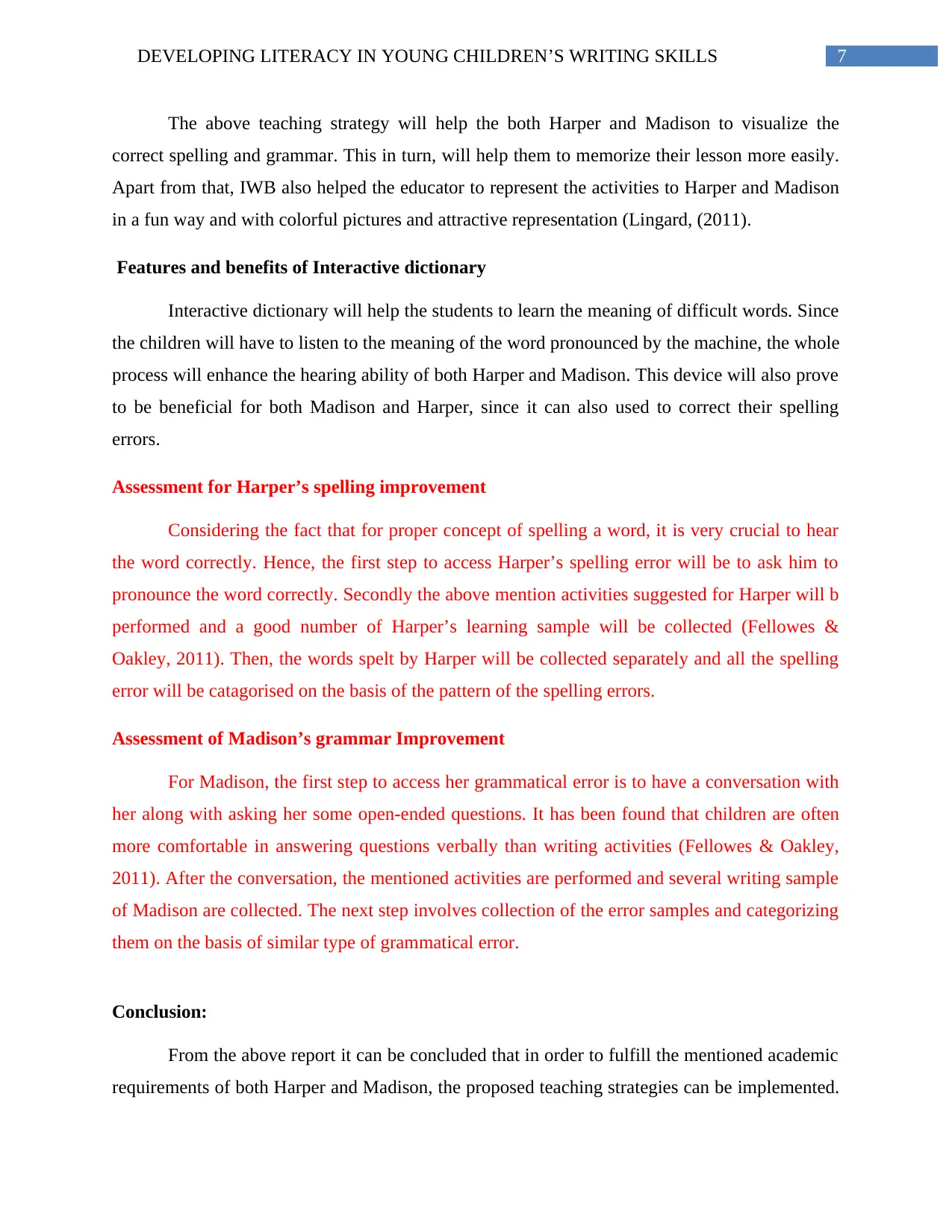
7DEVELOPING LITERACY IN YOUNG CHILDREN’S WRITING SKILLS
The above teaching strategy will help the both Harper and Madison to visualize the
correct spelling and grammar. This in turn, will help them to memorize their lesson more easily.
Apart from that, IWB also helped the educator to represent the activities to Harper and Madison
in a fun way and with colorful pictures and attractive representation (Lingard, (2011).
Features and benefits of Interactive dictionary
Interactive dictionary will help the students to learn the meaning of difficult words. Since
the children will have to listen to the meaning of the word pronounced by the machine, the whole
process will enhance the hearing ability of both Harper and Madison. This device will also prove
to be beneficial for both Madison and Harper, since it can also used to correct their spelling
errors.
Assessment for Harper’s spelling improvement
Considering the fact that for proper concept of spelling a word, it is very crucial to hear
the word correctly. Hence, the first step to access Harper’s spelling error will be to ask him to
pronounce the word correctly. Secondly the above mention activities suggested for Harper will b
performed and a good number of Harper’s learning sample will be collected (Fellowes &
Oakley, 2011). Then, the words spelt by Harper will be collected separately and all the spelling
error will be catagorised on the basis of the pattern of the spelling errors.
Assessment of Madison’s grammar Improvement
For Madison, the first step to access her grammatical error is to have a conversation with
her along with asking her some open-ended questions. It has been found that children are often
more comfortable in answering questions verbally than writing activities (Fellowes & Oakley,
2011). After the conversation, the mentioned activities are performed and several writing sample
of Madison are collected. The next step involves collection of the error samples and categorizing
them on the basis of similar type of grammatical error.
Conclusion:
From the above report it can be concluded that in order to fulfill the mentioned academic
requirements of both Harper and Madison, the proposed teaching strategies can be implemented.
The above teaching strategy will help the both Harper and Madison to visualize the
correct spelling and grammar. This in turn, will help them to memorize their lesson more easily.
Apart from that, IWB also helped the educator to represent the activities to Harper and Madison
in a fun way and with colorful pictures and attractive representation (Lingard, (2011).
Features and benefits of Interactive dictionary
Interactive dictionary will help the students to learn the meaning of difficult words. Since
the children will have to listen to the meaning of the word pronounced by the machine, the whole
process will enhance the hearing ability of both Harper and Madison. This device will also prove
to be beneficial for both Madison and Harper, since it can also used to correct their spelling
errors.
Assessment for Harper’s spelling improvement
Considering the fact that for proper concept of spelling a word, it is very crucial to hear
the word correctly. Hence, the first step to access Harper’s spelling error will be to ask him to
pronounce the word correctly. Secondly the above mention activities suggested for Harper will b
performed and a good number of Harper’s learning sample will be collected (Fellowes &
Oakley, 2011). Then, the words spelt by Harper will be collected separately and all the spelling
error will be catagorised on the basis of the pattern of the spelling errors.
Assessment of Madison’s grammar Improvement
For Madison, the first step to access her grammatical error is to have a conversation with
her along with asking her some open-ended questions. It has been found that children are often
more comfortable in answering questions verbally than writing activities (Fellowes & Oakley,
2011). After the conversation, the mentioned activities are performed and several writing sample
of Madison are collected. The next step involves collection of the error samples and categorizing
them on the basis of similar type of grammatical error.
Conclusion:
From the above report it can be concluded that in order to fulfill the mentioned academic
requirements of both Harper and Madison, the proposed teaching strategies can be implemented.
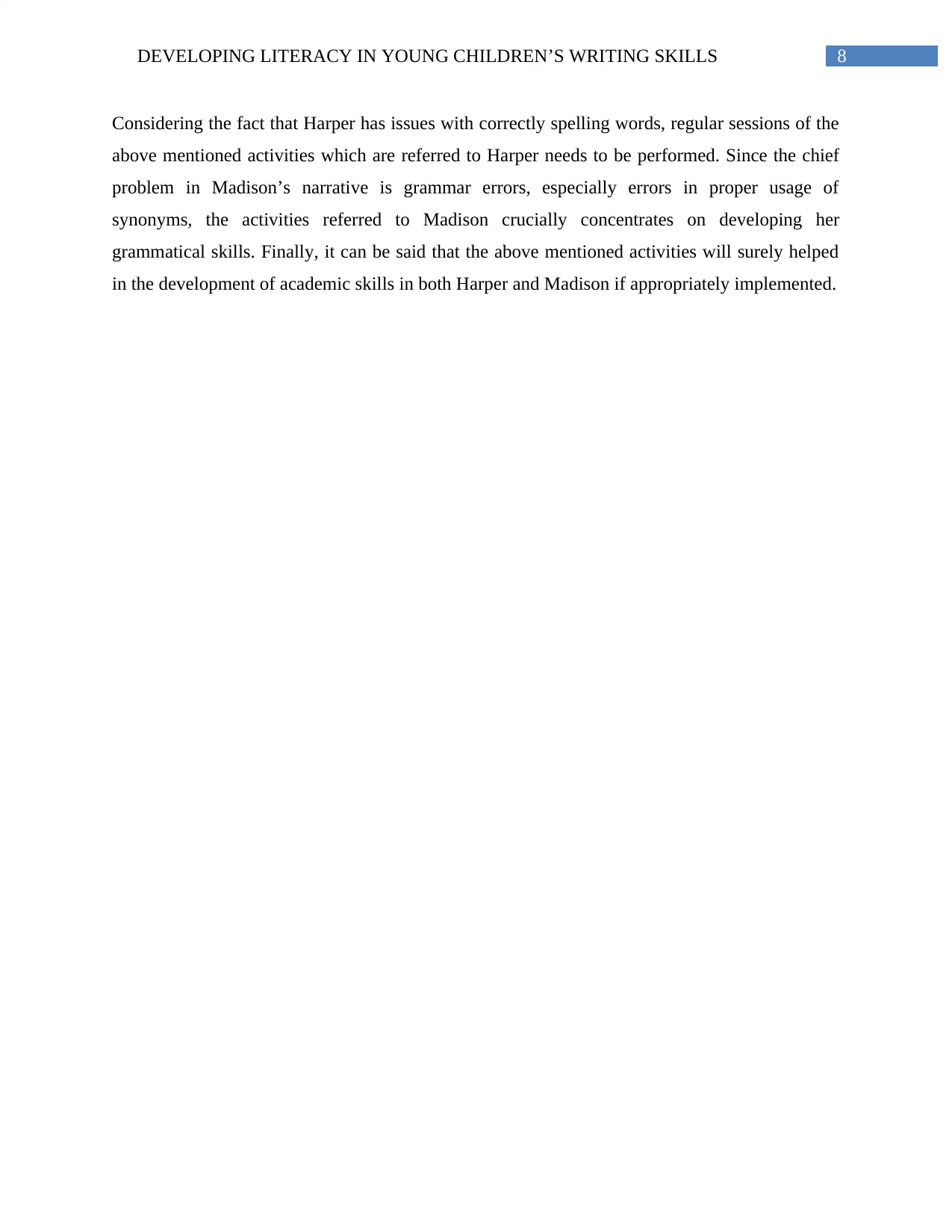
8DEVELOPING LITERACY IN YOUNG CHILDREN’S WRITING SKILLS
Considering the fact that Harper has issues with correctly spelling words, regular sessions of the
above mentioned activities which are referred to Harper needs to be performed. Since the chief
problem in Madison’s narrative is grammar errors, especially errors in proper usage of
synonyms, the activities referred to Madison crucially concentrates on developing her
grammatical skills. Finally, it can be said that the above mentioned activities will surely helped
in the development of academic skills in both Harper and Madison if appropriately implemented.
Considering the fact that Harper has issues with correctly spelling words, regular sessions of the
above mentioned activities which are referred to Harper needs to be performed. Since the chief
problem in Madison’s narrative is grammar errors, especially errors in proper usage of
synonyms, the activities referred to Madison crucially concentrates on developing her
grammatical skills. Finally, it can be said that the above mentioned activities will surely helped
in the development of academic skills in both Harper and Madison if appropriately implemented.
⊘ This is a preview!⊘
Do you want full access?
Subscribe today to unlock all pages.

Trusted by 1+ million students worldwide
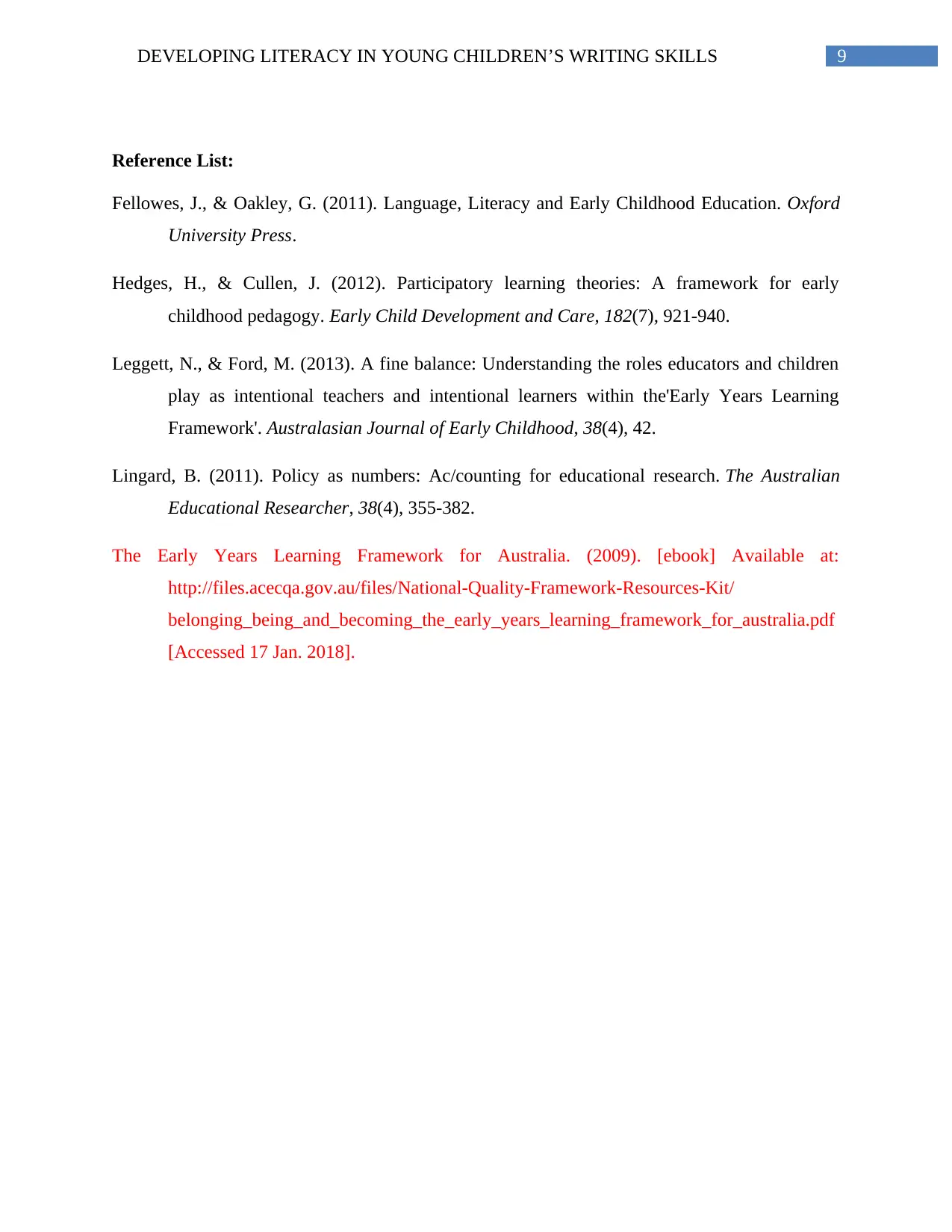
9DEVELOPING LITERACY IN YOUNG CHILDREN’S WRITING SKILLS
Reference List:
Fellowes, J., & Oakley, G. (2011). Language, Literacy and Early Childhood Education. Oxford
University Press.
Hedges, H., & Cullen, J. (2012). Participatory learning theories: A framework for early
childhood pedagogy. Early Child Development and Care, 182(7), 921-940.
Leggett, N., & Ford, M. (2013). A fine balance: Understanding the roles educators and children
play as intentional teachers and intentional learners within the'Early Years Learning
Framework'. Australasian Journal of Early Childhood, 38(4), 42.
Lingard, B. (2011). Policy as numbers: Ac/counting for educational research. The Australian
Educational Researcher, 38(4), 355-382.
The Early Years Learning Framework for Australia. (2009). [ebook] Available at:
http://files.acecqa.gov.au/files/National-Quality-Framework-Resources-Kit/
belonging_being_and_becoming_the_early_years_learning_framework_for_australia.pdf
[Accessed 17 Jan. 2018].
Reference List:
Fellowes, J., & Oakley, G. (2011). Language, Literacy and Early Childhood Education. Oxford
University Press.
Hedges, H., & Cullen, J. (2012). Participatory learning theories: A framework for early
childhood pedagogy. Early Child Development and Care, 182(7), 921-940.
Leggett, N., & Ford, M. (2013). A fine balance: Understanding the roles educators and children
play as intentional teachers and intentional learners within the'Early Years Learning
Framework'. Australasian Journal of Early Childhood, 38(4), 42.
Lingard, B. (2011). Policy as numbers: Ac/counting for educational research. The Australian
Educational Researcher, 38(4), 355-382.
The Early Years Learning Framework for Australia. (2009). [ebook] Available at:
http://files.acecqa.gov.au/files/National-Quality-Framework-Resources-Kit/
belonging_being_and_becoming_the_early_years_learning_framework_for_australia.pdf
[Accessed 17 Jan. 2018].
1 out of 10
Related Documents
Your All-in-One AI-Powered Toolkit for Academic Success.
+13062052269
info@desklib.com
Available 24*7 on WhatsApp / Email
![[object Object]](/_next/static/media/star-bottom.7253800d.svg)
Unlock your academic potential
Copyright © 2020–2025 A2Z Services. All Rights Reserved. Developed and managed by ZUCOL.





